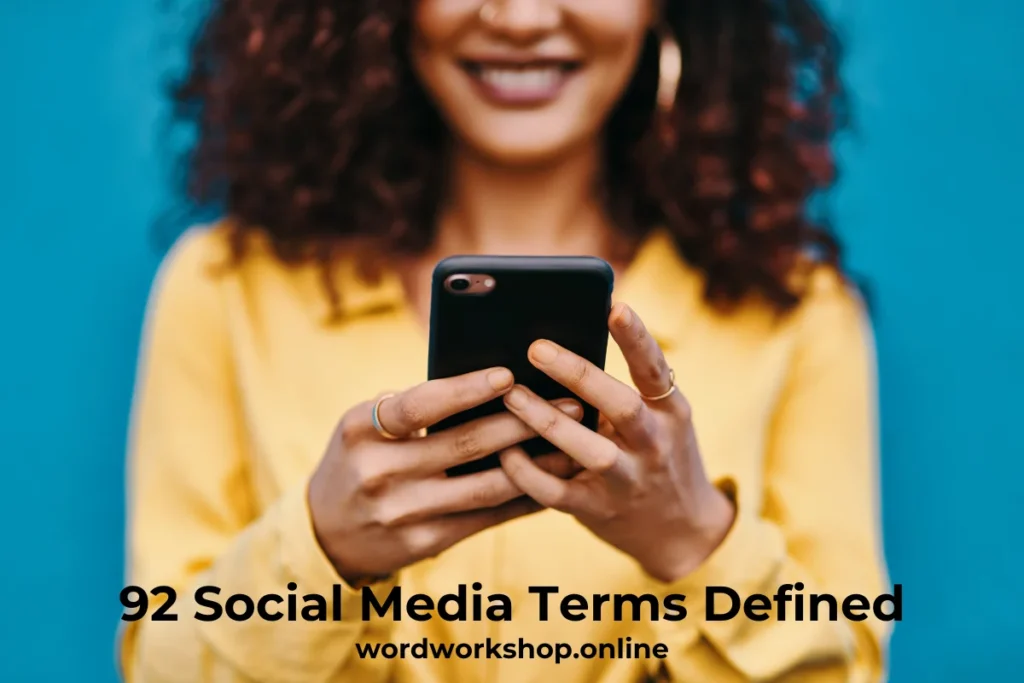We live in a digital world. We need to understand the language of that digital world in order to communicate effectively and intelligently. Social media includes all channels that connect us socially. The term media no longer applies to just TV, radio, or news. It now includes the social media platforms.
We need to get a good understanding of social media abbreviations, shorthand, and terminology if we are going to interact and stay connected with friends, family, potential readers, buyers, listeners, etc. Social Media is a tool we can use as authors, entrepreneurs, and those in ministry who have a message. You must let people know about you, your product, or your service.
To do this you need to create a Social Media Platform. Cindy’s book, Social Media Marketing for Authors, Entrepreneurs, and Ministers (Order your ARC – advanced reader copy today for $15 and save $5 Just pay $15 today) will help you develop relationships, understand the needs or problems of others, and offer solutions to those problems.
You social media platform needs to consist of a minimum of three channels or sources. Your website, Facebook, and YouTube or Twitter. Your platform needs to be personalized for your particular needs. You probably already have some basic channels in place. Cindy’s book shows you what social channels are available and gives you step-by-step instructions on setting them all up and getting started, then using them to market yourself, your book, your product, service, or message.
Before you get started you must become familiar with the terms you have already seen or will see on the Internet. You need to be as savvy as you possibly can so you can be as professional as possible. Hours of research led to this compilation of 92 terms I felt were the most important for you to know as a social media marketer.
Social Media Terminology
- Avatar –An icon or figure representing a person/user.
- Blogosphere – The entire blogging environment on the Internet.
- Blogs – A weblog. Content is usually 200 – 500 words. Blogging platforms include Blogger and WordPress.
- Bio – ‘Bio’ is short for biography. It is the small portion of your online profile that explains to new or potential followers who you are. All social platforms have some version of a Bio as they are valuable in attracting new followers with similar interests.
- Bitly – A URL shortening service that makes sharing long website addresses quicker and easier.
- Board – A category that you create in order to organize your pins on Pinterest.
- Bookmarking – Saving the address of a website or item of content, either in your browser or on a social bookmarking site like del.icio.us.
- Boosted Posts – Paid to advertise on Facebook.
- Browser – The tool used to view websites and access all the content available there onscreen or by downloading. Browsers may also be used to upload or otherwise contribute content to a blog or other website.
- Channel – A user’s customizable homepage for their social media account. Includes account information, and subscribers.
- Circles – Categories created to organize your followers on Google.
- Comments – User-generated feedback on an online news article or blog post.
- Communities – A forum created by brands or individuals to discuss certain topics, services, or to share information in general.
- Connections – Connections are people you connect with on LinkedIn.
- Content – Any kind of meaningful information (text, photos, videos, audio, etc.) on the Internet.
- Cover Photo – The large, horizontal image at the top of your Facebook profile or page. Similar to a profile photo, a cover photo is public and can be seen by anyone. This is a great place for individuals, brands, and organizations to use unique images to represent who they are, what their business is, or what they care about.
- Creative Commons License – A Creative Commons license allows you to keep the copyright of your work but allows others to distribute your work on other social media or social networking websites.
- eBook – A book published in digital form.
- Endorsements – A list of skills on LinkedIn that others agree you possess.
- Engage – Attracting attention and actively involving people in a conversation.
- Extended Circles – Google has circles, and close contacts, and then your circles have circles of their friends.
- Facebook Group – A space on Facebook where you can communicate and share content with a select group of people. There are three types of groups: public, closed, and secret.
- Facebook Live – Live videos or live streaming lets you share live videos with friends and followers.
- Facebook Messenger – Facebook Messenger or (Messenger) is an instant messaging service. Instantly connect and chat, share info, photos, etc.
- Fan/company/brand/group page – A collection of individuals sharing something in common on Facebook.
- Fan – A user who follows and receives updates from a particular Facebook page.
- Feed – A news feed of updates posted by your friends, as well as from groups and pages to which you have subscribed.
- Follow/Follower – To follow someone you must subscribe to receive their updates. A follower follows you by subscribing to receive your updates. This is a one-way connection.
- Forum – An online message board on a particular niche topic or subject that features an active user base.
- Friends – Friends are people you connect with on Facebook. It is a two-way connection. Friends can see your Facebook profile.
- Groups – A place for users to connect with others with similar interests.
- Hangout – A Google video chat that hosts up to 10 participants.
- Hangout on Air (HOA) – A broadcasted Google Hangout that can be watched live from a user’s Google Plus page. After the Hangout has finished, it can be found both on the user’s Google Plus page or their YouTube page.
- Hashtag – A single word or phrase preceded by the # symbol to define messages relating to a particular topic. #cindyhyde #socialmediamarketing
- Header Image – The banner image at the top of a user’s Twitter profile.
- Instagram – Allows users to share pictures and videos, apply filters, and also share them on other social networking sites.
- Keywords – Keywords are the descriptive words that describe a piece of media. A good use of keywords makes it easier for a website, article, or video to be found on search engines.
- Like – A one-click option allowing people to signify their enjoyment of a post.
- LinkedIn – The social network for businesses and professionals. Individuals and companies can make connections with others and create profiles.
- Member – A person who has joined and participates in a group.
- Microblogging – Short messages posted on a social media account like Twitter.
- Nanoblog – Short messages of 140 characters.
- Networks – The process by which you develop and strengthen the relationships.
- Newsfeed – A newsfeed is a list of news posted on a Facebook profile page, on blogs, and on Twitter.
- Notes – Notes are blogs or articles on your Facebook.
- Notification – A message sharing new social media activity.
- Paid Reach – The number of people who saw your post due to paid promotion.
- Paid Social Media – Businesses pay to advertise on social media like Facebook Ads, LinkedIn Sponsored Content, and YouTube-sponsored videos.
- Pin – Any image or website “pinned” to a Pinterest Board.
- Pinterest – A photo-sharing site where users create themed image collections around events, interests, or pastimes.
- Podcast – A podcast is a digital audio file series created by a user and is available for download on the internet.
- Post – A post made on social networking sites.
- Profile – A page that displays your personal information, profile picture, contact information, and other content you have chosen to share.
- Reach – The total number of people who saw your post (includes organic and paid reach).
- Recommendations – A written reference by a LinkedIn member, usually recognizing a colleague, student, or manager.
- Response – A user’s reaction or feedback on a post.
- Response Time – The time it takes to respond to a message from a user.
- Retweet – A tweet that is re-shared on your Twitter channel
- Request – One contact desires to connect with another.
- RSS – An acronym for Really Simple Syndication.
- SEO – Search Engine Optimization.
- Searching – Seeking information on the Net is done using a search engine, of which Google and Bing are the best known.
- Scheduling – Planning social media updates and content ahead of time, using a social relationship platform (SRP) or another publishing tool. Scheduling saves time. You can draft several messages at once and schedule them to post to your social media at different dates and times. It helps reach audiences in other time zones.
- Selfie – A self-portrait photograph shared on social media sites.
- Share – A one-click way of sharing a status, link, or image with your friends.
- Social Media – is the platform/tool.
- Social Networking – is the act of connecting on social media platforms.
- Social Media Marketing – is how businesses join the conversation in an authentic and transparent way to build relationships.
- Social Mention – This is a social networking search engine that allows you to search the internet for social content such as blogs, comments, bookmarks, events, news, and videos. Google also allows you to search blog, video, and image content.
- SMS – Text messaging service component of phone, web, or mobile communication systems.
- Spam – Unnecessary and repetitive social media content that clogs up the feeds of social media users. In other words, junk mail, or junk messages.
- Status update – Users can say what’s on their mind, check-in, tag who they’re with, and/or upload photos. The status update will appear on the newsfeed of their friends.
- Subscribing – The process of adding an RSS feed to your newsreader. It’s the online equivalent of signing up for a magazine, but usually free.
- Tag – Keywords attached to a blog post, bookmark, photo, or other items of content so you and others can find them easily through searches
- Thread – A trail of conversations in a social media platform, forum, or bulletin board, typically beginning with an original post and continuing with comments and conversation attached to that original post.
- Timeline – A news feed of updates posted by friends.
- Traffic – Refers to the number of visitors to a website.
- Trending – A popular topic that is popular on social media. Originating with Twitter, users add hashtags to particular words to join the discussion surrounding a topic. This can improve engagement with posts.
- Tumblr – A popular microblogging platform used to broadcast messages. 69% of Tumblr users are millennials.
- Twitter – Twitter at its most basic level, is a platform for posting short messages (nanoblogs or microblogs). Twitter has around 230 million active users.
- Tweet – The name given to messages posted on Twitter. Tweets are microblog messages that can be a maximum of 140 – 280 characters in length.
- User-generated content – Uploads by customers on their own social media platforms can be posted on your platform for authentic and genuine feedback, reviews, testimonies, endorsements, etc.
- Updates – News feeds sent to you from pages that you have joined.
- Upload – To transfer a file or other content from your computer to an Internet site.
- Views – The number of views on your YouTube platform.
- Viral Marketing – A marketing technique where information is passed electronically from one internet user to another, leading to wide coverage and high interest level.
- Vlog – Is short for video blog. Instead of writing everything you can create a video about it.
- Wall – The space on a profile or fan page where users can share posts, photos, and links.
- Web 2.0 – A term that describes blogs, wikis, social networking sites and other Internet-based services that emphasize collaboration and sharing, rather than less interactive publishing (Web 1.0). It is associated with the idea of the Internet as a platform.
- Webinar – Webinars are online seminars or presentations held by an individual or team to teach or inform about a topic to an audience. These are available pre-recorded or live streamed.
- Wiki – Simple web pages similar to an encyclopedia (Wikipedia) that can be edited by other users.
- YouTube – Google-owned YouTube is a video sharing website where users can upload, view and share video clips.




I am not sure where you’re getting your info, but good topic. I needs to spend some time learning much more or understanding more. Thanks for magnificent info I was looking for this information for my mission.
Beat with the North Yeah me it s